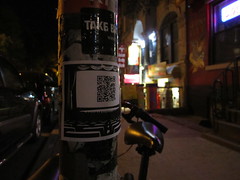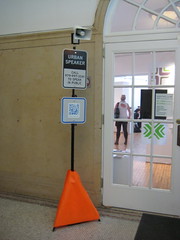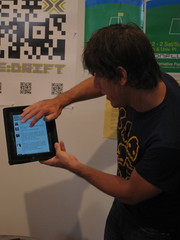 Carolyn Stanley A sticker for the Barcode Cinema project, one of the walkable exhibits at the Conflux Festival.
Carolyn Stanley A sticker for the Barcode Cinema project, one of the walkable exhibits at the Conflux Festival.The East Village became a technological playground of sorts this weekend: an 8-foot tall “Urban Speaker” received phone calls and broadcast them across Tompkins Square Park. Images of bustling city sidewalks flickered across an outdoor movie screen attached to the handball court fence near Avenue B. Custom-designed barcode stickers were affixed to street signs, lampposts and buildings.
A mix of events, activities, and installations were dispersed throughout the neighborhood, all part of Conflux, an experiment in psychogeography, demonstrating how changing the urban landscape impacts people. Established in 2003, the Conflux Festival is an annual art and technology exhibition, and this year, most of the festival’s 75 projects appeared in the East Village. Exhibitors were encouraged to position their projects within a walkable radius, so they could explore how a community responds to participatory art.
The Urban Speaker, a tripod connected to cell phone and a loudspeaker, received about 200 calls during the four hours it was on display in the park Friday afternoon. Carlos J. Gómez de Llarena, a self-described media architect, wanted to encourage people to think about the ways mobile phones are used in public spaces.
The strongest reaction came from local children. “They literally freaked out once they knew they could yell to it and sing out loud,” said Mr. de Llarena “A group of girls kept calling it and running around the park as if they were chasing their screams.”
Other exhibits transformed the neighborhood in a less overt manner. The barcode stickers were a collaborative project, Barcode Cinema, designed by artists Kristin Lucas and Lee Montgomery. When the barcodes were scanned with a web-based mobile phone, an image of the user’s location appeared, then gradually erased itself pixel by pixel.
The smartphone was a recurring theme at Conflux. Love Box, an iPhone application, allows participants to tag specific sites with stories about their own amorous encounters. The creators, Sabine Gruffat and Bill Brown, hope that it will become a user-generated cultural map of one aspect of the East Village’s hidden past.
“There’s the way the city wants to present itself, and then there’s the way the city actually is: the deep history of spaces,” said Mr. Brown. On Sunday, the artists estimated that about six people had contributed stories. There’s one catch: Love Box is currently restricted to iPhone users. Ms. Gruffat and Mr. Brown acknowledge this means many East Village voices are left out.
Though exclusivity wasn’t their goal, the iPhone’s GPS and audio recording capabilities suited their artistic vision. As Ms. Gruffat explains it: “We had to submit to the technology.”
That software limitation proved problematic for some attendees. Stephanie Leduc and Patsy Van Roost, artistic event designers from Montreal, were disappointed that so many of the projects were technology dependent. “We don’t have an iPhone so we couldn’t do a lot of things,” Ms. Leduc said. “We were interested in more low-tech stuff.”
One project that didn’t require advanced gadgetry was called Optimism Pack. The artist, Rena Leinberger, spent Sunday afternoon affixing bright blue painter’s tape to the sides of buildings owned by New York University, to comment on the gentrification of the East Village.
Because the events occurred in public spaces, it is impossible to know how many locals engaged with the installations peppered across their neighborhood. But one East Villager’s attendance didn’t go unnoticed. Dennis Crowley, co-founder of Foursquare (an idea hatched in his East Village apartment) made an appearance at the festival Saturday to discuss the mobile application as a tool for enriching everyday experience.
Before he left for the day, he installed Love Box on his iPhone. He later confirmed that he took it for a test drive around the neighborhood. His impression?
“I really love apps that try to add a layer on top of the real world,” he wrote in an e-mail message. “You can def tell how interesting the space is about to become!”





